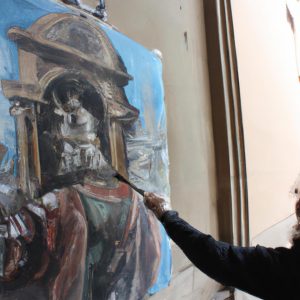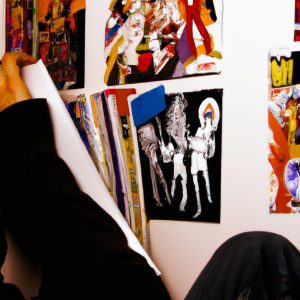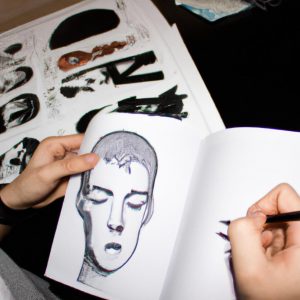Art Techniques: The Intersection of Arts, Comics, and Art History

Art Techniques: The Intersection of Arts, Comics, and Art History
In today’s art world, the boundaries between different artistic disciplines have become increasingly blurred. Artists are no longer confined to traditional mediums or techniques but instead explore new forms of expression that draw upon a multitude of influences. One such intersection exists between arts, comics, and art history, where artists integrate elements from these diverse fields to create compelling works. For instance, imagine an artist who combines the vibrant storytelling found in graphic novels with the rich visual language of classical paintings. By merging these seemingly disparate realms, this artist creates a unique synthesis that challenges conventional notions of what constitutes “fine art.” This article delves into the fascinating realm of art techniques at the crossroads of arts, comics, and art history to uncover how artists navigate this dynamic landscape.
The intersection between arts, comics, and art history offers a vast canvas for exploration and experimentation. As contemporary artists engage with various media and styles, they find inspiration not only within their respective fields but also by drawing upon historical references and pop culture influences. Through this interplay of traditions and innovations, artists forge new pathways that push creative boundaries while paying homage to established artistic legacies. From incorporating comic book aesthetics into large-scale murals to re creating iconic art historical works in a graphic novel format, artists are constantly redefining the possibilities of visual storytelling.
One technique that emerges from this intersection is the use of sequential art, commonly associated with comics, to convey narratives within traditional artistic formats. Artists blend elements of classic panel layouts and dynamic compositions found in comic books with the technical skill and aesthetics of fine art. This fusion allows for a new level of engagement and immersion for viewers, as they navigate through a visual narrative that combines the intricacies of painting or sculpture with the pacing and suspense inherent in comics.
Another technique seen at this intersection is the reinterpretation and subversion of art historical tropes within a contemporary context. Artists may take iconic paintings or sculptures from centuries past and reimagine them through a comic book lens. By incorporating speech bubbles, thought bubbles, or even altering the physical appearance of characters to resemble comic book heroes, artists create an interplay between highbrow art history and popular culture. This approach challenges preconceived notions of what is considered “serious” or “important” in art while inviting viewers to engage with familiar imagery in unexpected ways.
Additionally, artists working at this intersection often experiment with mixed media approaches that combine traditional materials with digital tools. They may incorporate hand-drawn illustrations into their paintings or digitally enhance their artworks to create dynamic effects reminiscent of comic book visuals. This blending of analog and digital techniques allows for greater flexibility and opens up new possibilities for artistic expression.
In summary, the intersection between arts, comics, and art history provides fertile ground for artistic exploration. Through techniques such as sequential art storytelling, reinterpretation of historical tropes, and experimentation with mixed media approaches, artists push boundaries and challenge conventions. By embracing diverse influences and mediums, they create compelling works that bridge gaps between different artistic disciplines while contributing to the ever-evolving landscape of contemporary art.
The Influence of Comics on Contemporary Art
Comics have long been considered a form of popular culture, often dismissed as mere entertainment. However, in recent years, there has been a growing recognition of the significant impact that comics have had on contemporary art. One example that highlights this influence is the work of artist Roy Lichtenstein. Through his iconic paintings such as “Whaam!” and “Drowning Girl,” Lichtenstein drew inspiration from comic book imagery, appropriating its bold lines, vibrant colors, and dramatic narratives to create visually striking artworks.
One way in which comics have influenced contemporary art is through their ability to challenge traditional notions of artistic expression. In the world of comics, artists are not confined by the limitations imposed by more conventional forms of art-making. They can experiment with different styles, incorporate text into images, and play with sequential storytelling techniques. This freedom allows for a dynamic interplay between visual and narrative elements that has found its way into the realm of fine art.
To further illustrate this point, consider the following bullet-point list:
- Comics offer a unique platform for social commentary and political critique.
- The combination of words and images in comics creates a powerful mode of communication.
- Comic book characters have become cultural icons, transcending their original medium.
- The accessibility and universality of comics make them an effective tool for engaging diverse audiences.
In addition to breaking artistic boundaries, comics also provide artists with a rich source material rooted in popular culture. By drawing inspiration from comic books, artists tap into shared nostalgia and collective memory. A three-column table presented below demonstrates how various artists have incorporated comic book aesthetics into their practice:
| Artist | Work | Comic Book Influence |
|---|---|---|
| Mel Ramos | “Wonder Woman” | Superhero iconography |
| Marjane Satrapi | “Persepolis” | Graphic novel storytelling |
| Takashi Murakami | “727” | Manga-inspired characters |
| Julie Mehretu | “Black City” | Abstracted comic book panels |
This integration of comics into contemporary art not only bridges the gap between high and low culture but also challenges traditional notions of what constitutes a valid artistic medium. In doing so, it opens up new possibilities for artists to explore and pushes the boundaries of artistic expression.
Transitioning into the subsequent section on “The Role of Art History in Comics,” it is evident that the influence of comics on contemporary art goes beyond aesthetics alone. By examining how artists draw from art history in their comic creations, we gain further insight into this intricate relationship between different forms of visual storytelling.
The Role of Art History in Comics
Building upon the previous section’s exploration of how comics have influenced contemporary art, this section will delve into the reciprocal relationship between art history and comics. By examining this intersection, we can gain a deeper understanding of how these two artistic mediums inform and inspire each other.
One fascinating example that highlights the connection between art history and comics is the work of artist Roy Lichtenstein. Lichtenstein drew heavily from popular comic book imagery in his iconic paintings during the 1960s. His piece “Whaam!” (1963) directly references a panel from DC Comics’ “All-American Men of War” series. This appropriation not only brought comic book aesthetics into the realm of high art but also sparked conversations about the fine line between originality and homage.
To further explore the role of art history in comics, let us consider four key aspects:
- Intertextuality: Comics often incorporate visual references to famous artworks or historical events, creating layers of meaning for readers familiar with their cultural significance.
- Stylistic Influences: Many artists draw inspiration from different periods in art history, adopting specific techniques or styles to enhance their storytelling.
- Narrative Structure: The sequential nature of comics allows for innovative storytelling techniques reminiscent of ancient frescoes or narrative friezes found in historical artwork.
- Symbolism and Allegory: Like traditional works of art, comics employ symbols and allegories to convey complex ideas or societal critiques within their narratives.
Table: Examples of Art History References in Comics
| Comic Title | Artwork Referenced |
|---|---|
| “Watchmen” | Leonardo da Vinci’s “Last Supper” |
| “Persepolis” | Edvard Munch’s “The Scream” |
| “Maus” | Pablo Picasso’s Guernica |
By incorporating these elements, comics bridge the gap between visual storytelling and art history, creating a rich tapestry of cultural references. This symbiotic relationship not only expands the possibilities for artistic expression but also invites audiences to engage with both mediums in new and thought-provoking ways.
Transitioning into the subsequent section about “Techniques Borrowed from Comics in Visual Arts,” we can see how this interplay between art history and comics has paved the way for artists to experiment with various techniques inspired by the sequential art form.
Techniques Borrowed from Comics in Visual Arts
Building upon the influence of art history, comics have found a unique way to incorporate visual storytelling techniques from various artistic movements. For example, let’s consider the case study of “Maus” by Art Spiegelman. This graphic novel masterfully combines elements of German Expressionism and Renaissance portraiture to explore the Holocaust narrative through anthropomorphized characters.
Comics artists often draw inspiration from specific art movements or styles, adapting them to convey their narratives effectively. The intersection between arts, comics, and art history gives rise to a fascinating amalgamation that captivates audiences across mediums. Here are some key ways in which comics borrow techniques from different art forms:
- Symbolism: Just like Surrealist painters used symbolic imagery to express subconscious thoughts, comic artists employ symbols within panels to evoke emotions and deeper meanings.
- Composition: Inspired by the principles of classical painting compositions, comic creators carefully arrange panels on a page to guide readers’ eyes and create visual impact.
- Color theory: Similar to how Impressionist painters experimented with vibrant color palettes and juxtapositions, comic artists strategically use colors for mood-setting and conveying atmosphere.
- Line work: Drawing inspiration from calligraphy or even Cubist paintings, comic illustrators manipulate lines to depict motion, depth, and texture.
To further understand these techniques borrowed from various art forms in comics, we can examine the following table:
| Technique | Originating Art Movement | Purpose |
|---|---|---|
| Use of Symbols | Surrealism | To evoke subconscious emotions |
| Composition | Classical Painting | To guide readers’ eye movement |
| Color Theory | Impressionism | To set moods and enhance atmosphere |
| Line Work | Calligraphy/Cubism | To depict motion, depth, and texture |
By incorporating these techniques, comics are able to bridge the gap between art history and visual storytelling. This fusion not only adds depth to their narratives but also allows for a rich visual experience that engages readers on multiple levels.
Transitioning into the subsequent section about “The Fusion of Art Styles in Comic Illustration,” we can explore how artists seamlessly blend various artistic styles to create unique comic illustrations. The combination of different techniques from diverse art movements results in visually captivating and dynamic artworks within the realm of comics.
The Fusion of Art Styles in Comic Illustration
Building upon the techniques borrowed from comics, artists have also been exploring the fusion of different art styles within comic illustration. This blending of artistic approaches creates a unique visual experience that captures both the essence of traditional fine art and the dynamic nature inherent to comics.
One fascinating example of this fusion can be seen in the works of artist Alex Ross. Known for his hyper-realistic style, Ross seamlessly combines elements from classical painting with comic book aesthetics. His artwork not only showcases the technical prowess associated with traditional portraiture but also incorporates vibrant colors and bold lines reminiscent of comic panels. By merging these seemingly disparate styles, Ross creates an engaging visual narrative that bridges the gap between high art and popular culture.
This convergence of art styles in comic illustration is made possible by several key factors:
- Collage: Artists often incorporate collage techniques into their work, layering various images and textures to create visually rich compositions.
- Mixed Media: The use of mixed media allows artists to experiment with different materials such as paint, ink, digital tools, or even found objects, enhancing the overall depth and texture of their illustrations.
- Typography: Playing with typography adds another dimension to comic illustrations. Artists utilize various fonts and lettering styles to convey emotions or emphasize specific aspects of their narratives.
- Color Theory: Employing color theory effectively enhances storytelling in comics. Artists strategically select palettes that evoke certain moods or symbolize themes within their illustrations.
To further illustrate how art styles are fused in comic illustration, consider the following table showcasing three prominent examples:
| Artist | Style | Notable Works |
|---|---|---|
| Jim Lee | Realism combined with | “Batman: Hush” |
| exaggerated proportions | ||
| Fiona Staples | Intricate linework merged | “Saga” |
| with painterly techniques | ||
| James Jean | Surrealism blended with | “Fables” |
| delicate watercolor |
By combining different art styles, these artists create visually stunning narratives that captivate audiences and push the boundaries of traditional comic illustration.
Transitioning into Exploring the Narrative Elements in Art, we delve deeper into how storytelling is interwoven within various artistic mediums. The fusion of art styles in comics sets the stage for an exploration of narrative elements beyond visual aesthetics alone.
Exploring the Narrative Elements in Art
Building upon the concept of art techniques and their impact on visual storytelling, it is important to explore how comic illustration incorporates various art styles from different periods in art history. This fusion of artistic elements allows for a rich and dynamic narrative that engages readers on multiple levels.
One example of this fusion can be seen in the work of renowned comic book artist Alex Ross. Known for his realistic portrayals of superheroes, Ross draws inspiration from classical painting techniques to create stunning illustrations that evoke a sense of grandeur and depth. By utilizing chiaroscuro lighting and meticulous attention to detail, he brings characters like Superman and Batman to life with an almost tangible realism.
To further understand this intersection between arts, comics, and art history, let us examine some key ways in which different art styles are incorporated into comic illustration:
- Expressionism: The use of bold brushstrokes and exaggerated forms creates a heightened emotional impact within panels.
- Cubism: Breaking down objects into geometric shapes adds complexity and abstraction to the visual narrative.
- Impressionism: Employing loose brushwork and vibrant colors captures fleeting moments with an ethereal quality.
- Surrealism: Incorporating dreamlike imagery challenges traditional perceptions of reality, adding layers of symbolism.
By combining these diverse elements within the framework of comic panels, artists not only pay homage to historical movements but also push the boundaries of what can be achieved within this medium.
| Style | Characteristics | Example |
|---|---|---|
| Expressionism | Bold brushstrokes, exaggerated forms | Edvard Munch’s “The Scream” |
| Cubism | Geometric shapes, fragmentation | Pablo Picasso’s “Les Demoiselles d’Avignon” |
| Impressionism | Loose brushwork, vibrant colors | Claude Monet’s “Water Lilies” |
| Surrealism | Dreamlike imagery, symbolism | Salvador Dalí’s “The Persistence of Memory” |
Through the fusion of art styles in comic illustration, artists create a unique visual language that engages readers on an emotional and intellectual level. By drawing inspiration from various periods in art history, they bring depth and complexity to their narratives.
Transitioning into the subsequent section about “The Evolution of Artistic Expression through Comics,” we can observe how these techniques have evolved over time to shape the way stories are told within this medium.
The Evolution of Artistic Expression through Comics
In examining the intersection of arts, comics, and art history, it is important to delve into the narrative elements that contribute to their unique storytelling techniques. By exploring how these elements are utilized across different mediums, we can gain a deeper understanding of the artistic choices made by creators and appreciate the impact they have on visual narratives.
One fascinating example of this intersection lies in the use of color symbolism to convey emotions and enhance storytelling. For instance, consider an artist who incorporates a vibrant red hue throughout their artwork to represent intense passion or anger within a particular scene. This deliberate choice not only adds depth to the narrative but also invites viewers to emotionally connect with the depicted characters or events.
To further comprehend how narrative elements are employed in art forms like comics, let us examine some common techniques used by artists:
- Panel Layout: The arrangement and size of panels within comic pages play a crucial role in guiding readers’ attention and pacing the story effectively.
- Speech Balloons: These thoughtfully placed speech balloons provide dialogue between characters, offering insight into their personalities and driving the plot forward.
- Onomatopoeia: Utilizing sound effects through visually represented words helps create atmosphere and heighten dramatic moments.
- Visual Storytelling: Through composition, perspective, and sequential imagery, artists craft visual narratives that transcend language barriers and engage audiences worldwide.
Table – Emotional Responses Elicited by Narrative Techniques
| Narrative Technique | Emotional Response |
|---|---|
| Color symbolism | Intense connection |
| Panel layout | Controlled pacing |
| Speech balloons | Character insight |
| Onomatopoeia | Heightened drama |
By employing these various narrative techniques across art forms such as painting, sculptures, or even graphic novels, creators can skillfully communicate complex stories while evoking emotional responses from their audience. It is through this interplay between medium-specific techniques and overarching narrative elements that the intersection of arts, comics, and art history truly comes to life.
In this section, we have explored how narrative elements are integral to visual storytelling. By delving into specific examples and discussing common techniques used in various mediums, we can appreciate the intricate ways in which artists bring narratives alive through their creative choices. Whether it is through color symbolism or panel layout, these tools enable creators to engage audiences on a deep emotional level while simultaneously showcasing the evolution of artistic expression throughout history.



